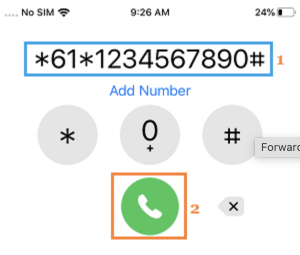In business, missed calls can equal missed opportunities. Every time a customer goes to voicemail, a competitor’s service steps in to take your place. But you already have the solution to this problem. In fact, it’s been available for the last 60 years.
We’re talking about call forwarding.
Forwarding is when unanswered calls are sent to a different number. If you receive a call but you don’t answer within a set number of rings, another number picks up the call. And the customer won’t even notice.
Shortly after the invention of call forwarding, another feature became the new standard for missed calls: voicemail.
Voicemail can seem like a good idea: you don’t have to pay someone to pick up the phone, and you can check messages in your own time, but does it help businesses?
The short answer is No.
The hidden cost of voicemail
According to Forbes magazine, 80% of callers hang up when they hear a recorded message. And this is a number that is only increasing over time.
Customers today demand immediate responses. Having a 24/7 answering service ensures your business is always available. If your business isn’t available, customers won’t wait for you to call back before going on to a competitor, especially if it’s an emergency call.
Voicemail’s biggest failure is sending people to a machine. Customers hate it. The benefit of forwarding is that the customer is guaranteed a human response, especially with a service like AnswerForce.
AnswerForce is committed to providing human connection at the core of everything we do. Whenever a customer contacts your business through us, they go straight to a real person—no AI and no voicemail.
Types of call forwarding
- Standard forwarding
- Conditional forwarding
Standard forwarding
Standard forwarding means that your main phone line will never ring. All calls are forwarded. It catches every call coming into your business and forwards them to another specified number
This kind of setup is great for:
-Out-of-hours
-Weekends or Holidays
-Working particularly manual jobs that require both hands
Conditional forwarding
This type of forwarding is focused on specific situations. Your business phone will ring a specified number of times before the call is directed to another number.
This kind of setup is great for:
-Unknown numbers you don’t have time to answer
-When you’re unsure if you’ll be available during the day
-If you’re already on a call
How do I set up call forwarding?
Don’t worry, it’s very straightforward. We’ll take you through the steps of setting up call forwarding options for both iPhone and Android – for all calls, on a conditional basis, or if you are using Google Voice.
Setting up standard forwarding
For iPhone, you need to:
-Open settings
-Select phone
-Select call forwarding and turn it on
-Enter the number you’d like your calls to be directed to
For Android, you need to:
-Open the phone dialling app
-Select the three vertical dots (settings)
-Select call forwarding or supplementary services
-Call forwarding and always forward
-Enter the number you’d like to direct your calls and press enable
With AnswerForce the number you enter at the end will be the toll-free business number we provide for you
Setting up conditional forwarding
Again this is very straightforward, however a little different between iPhone and Andriod.
For iPhone, you need to dial 1 of 3 numbers. *61, *62, *67, then the phone number you’re forwarding to followed by a #, then call it. It should look like this:

The reason there are three different numbers at the start is because they set different conditions.
*61– Forwards unanswered calls
*62– Forwards when you become unreachable due to poor connectivity
*67– Forwards when you are busy on another call
For Android
-Open the phone dialling app
-Select the three vertical dots (settings)
-Select call forwarding or supplementary services
-Then select from the list of conditional call forwarding options
Some network providers require you to dial a specific forwarding code. If you would like to read into this further please follow this link
How to cancel all call forwarding features
This is very simple. It’s even the same for both Android and iPhone. Open up the dialling app and dial ##004#.
When you ring this number nobody will answer but it will reset your phone back to its original/default call forwarding settings, which is not to forward at all.
Why would you need call forwarding?
Call forwarding allows you to focus on the job at hand. Customers are forwarded when ringing your service, they never realize they are speaking to someone outside the office, but only when a 24/7 answering service is employed. Instead of spending your workday filtering your calls, companies like AnswerForce take the reins.
A further advantage is that despite being a solution nearly 60 years old, call forwarding has moved with the times. It can now be integrated with a number of ‘smart’ voice options, such as Google Voice, and synced across your smartphone and desktop so that calls, and messages, are routed exactly where they should be, every time.
If you choose to forward your calls in your business, using a call script is highly beneficial. This ensures that whoever answers your calls knows exactly what to say. Virtual receptionists are perfect for this role.
When calls are forwarded to excellent virtual receptionists, callers can expect:
- Fast, instant response levels
- Courteous and helpful service
- Empathetic engagement
In short, the forwarding process makes your business available when you are not. Your team can return to the jobs where their skills and talent are most needed, without having to stop and answer the phone. Your customers get a better experience, and you get more business opportunities.
That’s why AnswerForce is so valuable. They can pick up any forwarded calls 24/7 and are specialized in the service industries. So next time your business is overflowing with requests, let us handle them.



